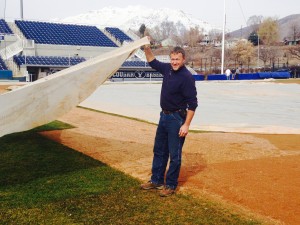BYU Grounds works hard each winter to ensure the field withstands the icy cold well enough to be ready for the baseball season.
Brian Hill, the baseball and softball grounds leader, has been maintaining BYU’s fields since 1999, and BYU’s grounds for 24 years come this March.

“It’s neat for me to see that the players know who my staff is and interact with them. That makes my guys step up more and feel valuable. This is our field, and it’s nice to be a part of the team,” Hill said.
Plenty of work goes into assuring the dirt is firm and the grass is smooth and cut short so it won’t slow down the baseball when it hits the field.
“The grass is very important,” Hill said. “If it’s shorter grass you won’t have as much blade standing up to slow the ball down.” The tarps that cover the grass help to keep moisture in so that it does not dry out.
Even more important than the grass is the dirt on the field. To give the dirt the right amount of firmness, the grounds crew covers it with giant silver tarps that keep rain and snow out.
Last fall, the team practiced until early December. The crew couldn’t cover the fields fast enough and had a foot of snow on the ground.
“When everything melted, we put the tarps on and still had two inches of snow,” Hill said. “The tarps melted the snow, warmed the ground, and now the water can go down through the soil. The tarps keep rain out so that it can dry out.”
Moving the tarps on and off the field requires substantial manpower.
“We like as many men as possible to help us move the tarps. There are 18 handles per side, and the tarp is 107 ft. square,” Hill said.
Because of the players’ constant sliding and time on the dirt, it’s very important that the dirt be smooth. It cannot be too soft or too hard; it has to be firm. “The best thing to make the field firm is water,” Hill said.
They cover it to keep rain and snow out, but once the sky clears, the crew uncovers the dirt and begins to water it. The dirt needs a controlled amount of water to reach the right firmness.
“People I’m sure look at us and think we’re crazy, but that’s how you manage the field,” Hill said.
If there are holes in the field, the water will collect and make it softer, so Hill and his crew work to keep an even field.
“The players want to be able to push with their cleats, and the ground won’t give. Also, you don’t want to chew up the ground because it will make clods that can change the ball’s direction,” Hill said. “We have to micromanage that surface and get as much water in there as possible.”
On game days, the crew waters the field all day. And then, one hour before the game starts, they stop watering it. That hour-long period gives the top of the field time to dry off so the soil is full of water. As the players push on it, the water reaches the surface but does not spill out.
“It’s like a sponge: You push on it, and the water comes to the surface. That gives them a firm footing,” Hill said.
Right now, the dirt is not muddy but is still too spongy; too much water comes out if the players push on it hard enough. Hill is hopeful that by next week the team can start practicing on the field.
The first home game is March 4 for BYU baseball and March 25 for BYU softball.




